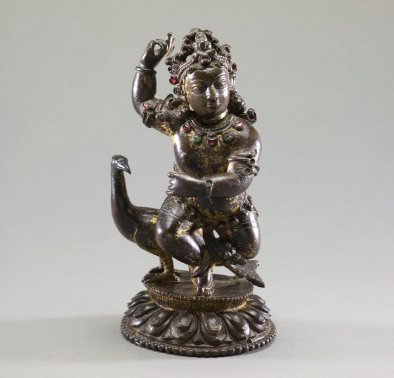
Today in Nepal, people are celebrating the festival Sithi Nakha, which serves as preparation for the upcoming monsoon season. Here are some key facts you need to know about the festival, which honors Kumara, the rain baby of the Kathmandu Valley.
Nepal’s summer season comes earlier than in the United States
Here in New York, summer is just on the horizon. However, for those living in the Kathmandu Valley and monsoon regions, summer comes a bit earlier . Starting in late April and early May, Nepal becomes very hot and dry. Plants wither and die while animals estivate, which is like hibernating but during warm weather months. When the monsoons arrive in June, they signal a return to life, much like the sun does during the spring in other locations.
The monsoon is believed to “gestate” in the sky
To understand Sithi Nakha, we must first look to fall of the previous year. After the monsoons conclude in September, the people of the Kathmandu Valley celebrate the harvest with impressive jatras or street festivals. Along with giving thanks and honoring the gods, a part of these festivals also serves to ritually “impregnate” the sky. Once the sky is pregnant, it’s believed the clouds “gestate” for a period of about nine months before giving birth to the monsoon rains.
The festival is a birthday party for Kumara, Nepal’s “Rain Baby”
Traditionally, Sithi Nakha marks the first rain of the season before the full monsoon torrents begin to fall. Simultaneously it also marks the birthday of Kumara, the son of Shiva and Paravati and the archetypal “rain baby” for the Nepalese people.

Throughout most of South Asia, Kumara is generally depicted as a fierce, youthful, and strong warrior. In this sculpture from the 11th century, he appears as a young child sitting on a peacock and holding a spear. The pre-monsoons also mark the mating period for peacocks, emphasizing Kumara’s connection to this particular time of year.
Though in the mind of the Nepalese people Kumara is a child, he still is powerful and has wrathful tendencies. Therefore, if he is not properly appeased, he can bring great harm to the rice harvest that year. Only after the sky goddess gives birth to Kumara and the first rains come can the people of the Kathmandu Valley begin to plant their rice paddies for the autumn harvest.
Cleaning water spouts is one of many Sithi Nakha traditions
Before the monsoons fall, the valley becomes increasingly dry, and many public pools and water collection spouts fall to their lowest levels. Part of the celebration of Sithi Nakha is cleaning these public pools in preparation for the monsoons. Nepalese families will also prepare feasts making pancakes from particular grains to use as offerings for the Rain Baby. Pinwheels are put on display as well tracing the movements of the wind helping make predictions for the rains to come.

Discover more connections between Nepalese culture and the monsoon rains at the Rubin Museum exhibition, Nepalese Seasons: Rain and Ritual. And join us for a celebration of festivals like Sithi Nakha at our upcoming Block Party.
Add Your Thoughts
Comments are moderated, and will not appear on this site until the Rubin has approved them.


Thank you so much for the briefing about our culture.. It really amazed and useful article for all who love our culture..